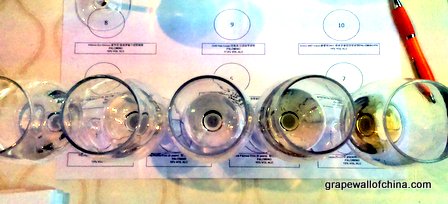~
By Jim Boyce
Winemaker Antonio Flores of Spanish operation Gonzalez Byass visited Beijing last week and led several Sherry tastings, including one I joined at newly opened bar Parlor. Flores outlined the “pillars” of his craft, including soil, grapes, alcohol levels, aging styles and blending techniques, and explained the importance of “flor“, a combination of yeast and other material that forms like “cheese curds” on the surface of some sherries and serves both to impart flavor and serve as a seal against air.
Anyway, we started the tasting with five dry sherries, including Tio Pepe, aged at least four years, and the limited edition “Palmas“ range. The latter four wines are aged six, eight, ten and forty-plus years respectively and essentially reveal Tio Pepe as it grows up. As Flores said, while we tried the last one, “This used to be a Tio Pepe so the memory of that is in the background.” I hid at the table’s far end and took the following notes as I tried — I was nearing the end of a chest cold — not to cough on anyone.
With Tio Pepe, I smelled greenness (unripe Bartlett pear skin) and mild nutty liqueur, and found it fresh and dry, with some nutty flavors and a slightly bitter citrus-y finish. The darker Una Palma Fino (6 years) had sweeter and nuttier liqueur aromas, a fuller body and that same touch of bitterness — someone said it was almond — at the finish, while Dos Palmas Fino (8 years) smelled less intense if even sweeter and nuttier (“brioche”, said Flores) but compensated for it with a bigger body that included some savoriness and, at the finish, spiciness.
The Tres Palmas Fino (10 years) further showed the maturing Tio Pepe, with a lighter nuttiness (less almond, more chestnut, said someone) and greenness. It is lean and complex, with — I assume from barrel age — more vanilla flavor. Finally, Tres Palmas Amontillado (40-plus years) — unlike the others, it spent most of its life without flor, some thirty-plus years — is Tio grown up. This smells like sweet hazelnut, brioche, dried fruit and resin (Flores said “varnish”). I found it intense and well-structured, with a salty finish that reminded me of a hoppy beer.
Flores said these are called “handkerchief wines” because you add a couple of drops of sherry to one and carry the smell wherever you go. “It’s perfume.”
We finished with two more bottles. One was the Alfonso Dry Oloroso that had bread, orange, syrup and dry wood aromas and lots of nutty flavors, and seemed to be particularly popular among the tasters. The other was Nectar Pedro Ximenez, the only wine we tasted not made from Palomino fino grapes. If you like Fig Newtons, this is for you. It had fig, hazelnut, maple syrup, fig, coffee, chocolate and fig smells, and I found it sweet and viscous but not overly cloying. I can see why a friend recommends it dribbled over vanilla ice cream. (With a few Fig Newtons on the side.)
You can get these sherries from Tinta Fina. For those living in Beijing, I’m told Tres Palmas and Cuatro Palmas are already sold out and there are less than 20 bottles each of Una Palma and Dos Palmas. If you’re a fan and keen to get some, you best act quickly by visiting The Loop. Also, the Tio Pepe site has tasting notes on the Palmas range here and the other sherries here.
(Note: Get my free Grape Wall e-newsletter. Subscribe here. Sample here. Follow on Twitter here.)
(From left) Antonio Flores of Gonzalez Byass with Thomas de Wangen of China-based distributor Tinta Fina and Beijing rep Weiley Lu.
Grape Wall has no sponsors of advertisers: if you find the content and projects like World Marselan Day worthwhile, please help cover the costs via PayPal, WeChat or Alipay.
Sign up for the free Grape Wall newsletter here. Follow Grape Wall on LinkedIn, Instagram, Facebook and Twitter. And contact Grape Wall via grapewallofchina (at) gmail.com.
